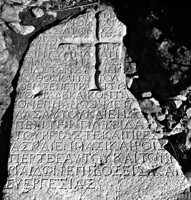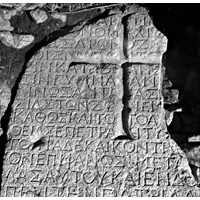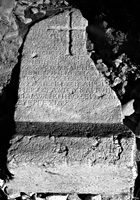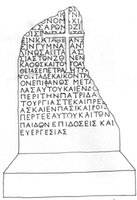 MAMA XI 3 (Apollonia)
MAMA XI 3 (Apollonia) 
Honorific inscription concerning gladiatorial munera and venationes
- Type of monument:
- Honorific inscription concerning provision of games.
- Location:
- Uluborlu (Apollonia): in a field-wall 50m east of Sait Demirdal’s house. Now (2012) in Uluborlu museum.
- Description:
- Creamy-white limestone base, broken above, with moulding below. On the upper part of the shaft, incised cross of later date.
- Dimensions:
- Ht. 1.17+; W. 0.63 (shaft), 0.82 (base); Th. 0.52 (shaft), 0.69 (base); letters 0.030-0.034.
- Record:
- Squeeze; line drawing; MB notebook copy; photographs (1956/86).
- Publication:
- Labarre, Özsait, Özsait and Güceren 2012: 127, no.5.
- Date:
- Second or third century AD.
[. . . . c. 9 . . . .]ΟΣ[- - - -]
[. c. 2 . (e.g.) δόντ]α κυ̣νη̣[γέσια]
[καὶ μο]νομα̣χία̣[ς ἡμέρων]
[τε]σσάρων ὀξέ̣[σι σιδή]-
5[ρ]οις ἐ̣ν πᾶ[σ]ι̣ το̣[ῖς ἀγῶ]-
σιν κατὰ θε[ί]αν σ̣[υνχώρη]-
σιν, γυμνά[σ]αν[τα καὶ χα]-
λινώσαντα [τ]ὰς [- c.6-7 -]
σίας τῶν ζῴ[ω]ν ἐν[δόξως (?)],
10καθὼς καὶ το[ῦ]το αὐ̣[τῷ παρὰ τῆς]
θείας ἐπετρά[π]η Τύχ̣[ης, ἀγα]-
γόν̣τα δὲ καὶ κοντρο̣[κυνήγι]-
ον ἐπιφανῶς μετὰ [τὰς ἄλ]-
λας αὐτοῦ καὶ ἐνδό[ξους]
15περὶ τὴν πατρίδα λ̣[ει]-
τουργίας τε καὶ πρεσ[βεί]-
ας καὶ ἐν πᾶσι καιροῖς [ὑ]-
πέρ τε ἑαυτοῦ καὶ τῶν
παίδων ἐπιδόσεις καὶ
20εὐεργεσίας.
[... who provide]d wild-beast shows and gladiatorial combats for four days, with sharp weapons in all the contests, by imperial permission, and who trained and bridled the - - of animals [in glorious fashion], just as this too was granted to him by the imperial Fortune, and who also presented a wild-beast hunt with lances in a most illustrious manner, subsequent to his other glorious liturgies and embassies on behalf of his homeland, and the distributions and benefactions which he has performed on every occasion on his own behalf and that of his children.








Published, with an inaccurate text and translation, by Labarre, Özsait, Özsait and Güceren 2012: 127, no.5. The honorand has provided wild-beast shows (venationes, κυνηγέσια) and gladiatorial combats (gladiatorum munera, μονομαχίαι) for four days: for the number of days over which such events took place (regularly between two and thirteen days), see Robert 1940: 280-1 (also I.Smyrna 637: five days). In lines 4-5, it is specifically stated that all the gladiatorial combats are to be ‘with sharp weapons’ (ὀξέ̣[σι σιδήρ]οις: Robert, OMS I 697-9); compare Robert 1940: 142, no. 97 (Sagalassos: ὀξέσι σιδήροις); I.Cret. IV 305 (Gortyn: τῷ ὀξεῖ σιδή[ρ]ῳ); I.Smyrna 637 (Robert, Hellenica V, 81-2: τοῖς ὀξέσιν); TAM V 2, 950 (Thyateira: τοῖς ὀξέσιν); IEphesos 810 (ὀξέσι); IMilet VI 3, 1141 ([τοῖς ὀξέ]σιν). Not all gladiators fought with sharpened weapons (Dio Cass. 71.29.4); that all combats over the four days of shows at Apollonia were fought with potentially fatal weapons was an additional draw for the public (Robert 1940: 258-62; Günther 1985: 127-9).
It appears that, at least by the late second century AD, specific imperial authorisation (indulgentia) was regularly required for gladiatorial munera and venationes which involved sharp weapons or which were fought to the death (ἀπότομοι, sine missione): see Robert 1940: 274-5, and above all Nollé 1992/3. This was a result of imperial concern over the excessive costs that liturgists could incur in the provision of spectacular munera (see especially the SC de pretiis gladiatorum minuendis of AD 177-80: Oliver and Palmer 1955). Thus in the third-century inscription TAM V 3, 1490 (Philadelpheia), we are told that the honorand provided a venatio in which the beast and hunter fought to the death ‘by imperial grant’ (lines 7-9: δόντα κοντροκυνηγέσιον ἐν ᾧ ζυγὸν ἀπότομον ἐκ θείας φιλοδωρίας); in TAM V 2, 950, from Thyateira, a high-priest of Asia was honoured by the emperor Severus Alexander with permission to celebrate his high-priesthood with sharp-weaponed gladiatorial contests (τιμηθέντα ὑπὸ τοῦ θειοτάτου Αὐτοκράτορος.. συνάψαι τὰς ἀρχιερεωσύνας τοῖς ὀξέσιν). In the fourth-century Gortynian inscription I.Cret. IV 305, the emperor grants permission for the honorand to hold three days of spectacular wild-beast hunts ‘in which he may kill as many beasts as he likes’ (ἔχοντα κατὰ θείαν μεγαλοδωρίαν θεατροκυνηγεσίων ἡμέρας τρεῖς ἐν αἷς ἀποσφάξαι θηρία ὅσα αὐτὸς ἐβούλετο). For the term συνχώρησις (=indulgentia), which I have restored here in lines 6-7, compare I.Beroia 69 (AD 240), lines 10-11: προσεισάγοντες... καὶ ἕτερον ζεῦγος περὶ τῆς ψυχῆς ἀγωνιούμενον πρὸς τοῖς νενομισμένοις δυσὶν κατὰ συνχώρησιν τοῦ κυρίου ἡμῶν Μ. Ἀντωνίου Γορδιανοῦ εὐσεβοῦς εὐτυχοῦς Σεβαστοῦ, ‘presenting also another gladiatorial pair who will fight to the death, in addition to the customary two pairs, by the permission of our lord M. Antonius Gordianus pius felix Augustus’.
I can find no close parallels for the phrase in lines 7-9. The verb χαλινοῦν, ‘tame, bridle’, seems not otherwise to be epigraphically attested, but it is hard to see what else we could restore here. In lines 8-9, we need to restore a feminine noun in the accusative plural; it is possible that we ought to restore [τ]ὰς [ἱππηλα]|σίας τῶν ζῴων, ‘the chariot-teams of horses’, but it would be surprising to find that specific imperial permission was required in order to train up animals for chariot-races. At the end of line 9, I have assumed that we have an adverb (e.g. ἐν[δόξως]) qualifying the participles γυμνά[σ]αν[τα καὶ χα]λινώσαντα in lines 7-8; for the placement of the adverb at the end of the clause, compare lines 11-13.
For the use of the verb ἄγειν in lines 11-12, compare Robert 1940: 149, no. 113 (Oinoanda), ἀγαγόντα κυνηγέσια καὶ μονομαχίας. In lines 12-13, we are told that the honorand provided a κοντρο̣[κυνήγι]ον, a wild-beast hunt with lances (Robert 1940: 312, 324). For the form κοντρο-, a contamination of κοντός and κέντρον, see Zingerle 1931: 81-3; the term is also attested in TAM V 3, 1490 (Philadelpheia: third century AD), lines 7-8: δόντα κοντροκυνηγέσιον. In I.Cret. IV 305 (Gortyn: fourth century AD), a benefactor is said to have provided three days of ‘lance-fights’ (σιδηροκοντρῶν δὲ ἡμέρας... τρεῖς, ὧν ἐν ἑκάστῃ ζεύγη ἀπότομα δύο καὶ θηρία σφακτά); for the term σιδηροκόντρον, see also Robert 1940: 142, no. 97 (Sagalassos); I.Milet VI 3, 1141.8-9. The weapon concerned may perhaps be that depicted on a relief from Dion in Macedonia and a mosaic from Reims (Robert, Hellenica VII, 126-8, with Pl. XVI 3 and XX; Hellenica VIII, 42-3, with Pl. XV 3), a long lance with a transverse bar just below the head, to prevent the hunter from driving it too far into the animal’s body in any one stroke: the weapon thus has some of the qualities of a goad (κέντρον).
For the phraseology in lines 17-19 (various local benefactions performed on his own behalf and that of his children), compare Kalinka 1895: 228-30 (Pericharaxis: πάσας ἀρχὰς καὶ λειτουργίας ὑπέρ τε ἑαυτοῦ καὶ τῶν παίδων καὶ τῆς γυναικὸς ἐνδόξω[ς] καὶ φιλοτείμως ἐκτελέσαντα); I.Prusias ad Hypium 49.8-10 (ἀγορανομήσαντα ὑπέρ τε ἑαυτοῦ καὶ ὑπὲρ [υἱοῦ]); Ramsay, Phrygia I 335, no. 155 (Baris: πάσας ἀρχὰς καὶ λειτουργίας ὑπέρ τε ἑαυτοῦ καὶ τοῦ υἱοῦ αὐτοῦ... τελέσαντα).
The honorand’s name and office are not preserved. However, we have some reason to think that he was a civic or provincial high-priest of the imperial cult. In the eastern Roman provinces, gladiatorial munera and venationes were usually provided by the high-priests of the imperial cult, both municipal and provincial (Robert 1940: 270-5; Carter 2004); at Aphrodisias, the provision of gladiatorial contests was obligatory for those appointed to the civic high-priesthood of the imperial cult until the reign of Hadrian (SEG 50, 1096.32-7).
A neglected funerary monument from Apollonia, MAMA IV 168, may well record the death of a venator in combat. The monument is a small bomos, on which is carved in low relief a standing figure, who holds above his head a prone body carrying a spiral object in his drooping right hand. The standing figure is labelled with the name Βάρβαρος; on the upper moulding of the bomos is inscribed the name Γν[. . .]λ̣ας, presumably the name of Barbaros’ victim.
The editors of MAMA IV (followed, tentatively, by Robert 1940: 61 n.1) believed that both figures were humans. However, the spiral object carried by the prone figure seems very likely to be a whip (not, as the editors of MAMA IV, a net), the characteristic tool not of the gladiator, but of the ursarius. Three relief sculptures, from Aproi in Thrace (Robert 1940: 90-2, no. 27, with Pl. XXIV), Kibyra (Robert, Hellenica VIII, 57-61, with Pl XX 3-4), and Ephesos (Robert, Hellenica VIII, 71-2, with Pl XXVI 2), depict bear-leaping contests in which one ursarius maddens a bear with a whip, while another (the salitor) leaps perilously over the bear’s back (Robert 1940: 326-7).
The standing figure on the bomos from Apollonia ought, therefore, to be identified as a bear, the killer of the unfortunate ursarius Γν[. . .]λ̣ας. Michael Ballance saw the bomos in 1956, in front of the Bülbül Çeşmesi in Uluborlu; although he did not sketch or photograph the bomos, he records in his notes (1956/91a) that ‘the larger of the two figures on the relief seemed in front of the stone to represent a bear rather than a man’. The bear carried the name Βάρβαρος: for the names given to animals in venationes, see Robert 1940: 157-8, 191-2.